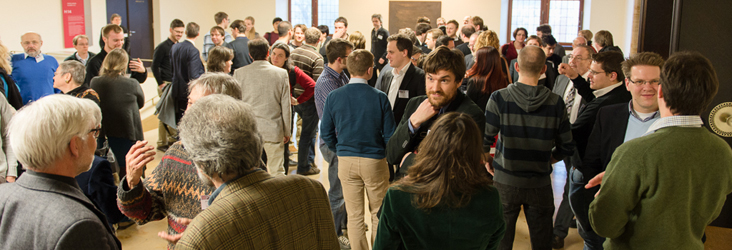
Events 2011
The Interdisciplinary Center for Scientific Computing (IWR) and its affiliated institutions organize a large number of events for discussing latest scientific results as well as identifing upcoming challenges in the field of Scientific Computing. In addition the IWR regularly hosts events which emphasis on broadening and improving the interdisciplinary dialogue.
Computations with Modular Forms 2011
September 5-8, 2011
Modular Forms play a central role and are of increasing importance in number theory and arithmetic geometry. The main focus of this conference is the development and application of algorithms in the field of modular and automorphic forms. Prior to the conference there will be a summer school covering several current themes between theory and computation of modular forms and aimed at young researchers and PhD students.
August 29 to September 2, 2011 (Summer School), September 5-8, 2011 (Conference)
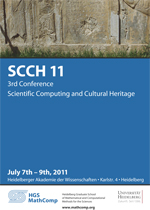
SCCH 2011: 3rd Conference on Scientific Computing and Cultural Heritage
July 7-9, 2011
Following two successful SCCH conferences in 2007 and 2009, the Interdisciplinary Center for Scientific Computing at Heidelberg University invites authors and guests to the 3rd SCCH workshop in Heidelberg, Germany. This time, the summer in Heidelberg will be packed with conferences as the university celebrates its 625th anniversary. We join this program and decided to choose three days in july to have a conference on this highly interdisciplinary topic. In cooperation with the Academy of Science, Baden Württemberg and endorsed by the German Excellency Initiative and the Heidelberg Graduate School (HGS), this workshop again focuses on topics of computational and mathematical modeling in application areas of cultural heritage. This emerging new scientific area covers a variety of disciplines.
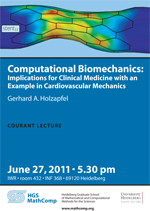
HGS MathComp Courant Lecture
Computational Biomechanics: Implications for Clinical Medicine with an Example in Cardiovascular Mechanics
Prof. G. A. Holzapfel, Graz University of Technology, Austria
June 27, 2011
Gerhard A. Holzapfel is Professor of Biomechanics and Head of the Institute of Biomechanics at Graz University of Technology (TUG),Austria.He is also Adjunct Professor at the Royal Institute of Technology (KTH) in Stockholm, Sweden, and Visiting Professor at the University of Glasgow, Scotland. His research includes experimental and computational bio- mechanics and mechanobiology with an emphasis on soft biological tissues.
The focus of the presentation is to provide a methodology for patient-specific modeling of balloon angioplasty and stenting, which is a purely mechanical procedure with the aim to dilate stenotic (or occluded) arteries to restore blood flow. In particular, we briefly review capable three-dimensional mathematical models for collagenous tissues such as artery walls and discuss their merits and drawbacks point- ing also to open issues in the field. We also provide computational analyses of patient-specific problems that occur in clinical medicine. In particular, we investigate drug-eluting stents when being implanted in the curved main branch of a coronary bifurcation. It can be shown that the resulting wall stress distributions depend strongly on the stent design.
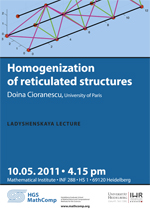
HGS MathComp Ladyshenskaya Lecture
"Homogenization of reticulated structures"
Prof. Doina Cioranescu, University of Paris
May 10, 2011
We consider a special class of multi-scale problems, concerning in particular thin composite reticulated structures (of lattice-type) which are periodic structures with big holes and a very small amount of material concentrated along layers (honeycomb structures) or along bars (reinforced structures). They may have a very complex geometrical pattern. From the mathematical point of view, it means that we have to treat partial differential equations depending on several small parameters. The aim here is to give the asymptotic behavior of the solutions with respect to these parameters (which can be the period of the heterogeneities, the thickness of the material, or the thickness of a plate or of a beam in case respectively, of gridworks or cranes).
For the dependence on the period, we use homogenization methods (such as the periodic unfolding in perforated domains) in the directions in which we have periodicity. For the dependence on the small amount of material, a perturbation method is used, enabling us to give explicitly good approximations of real structures. The dependence on the third small parameter is studied by plate and beam techniques. We also give error estimates showing that the final result, when the small parameters are small enough, is close to the original physical one. It is noteworthy that in all the cases we treat, we end up with simple partial differential equations with constant coefficients that are explicit algebraic expressions of the physical ones.
DAGM Workshop on Unsolved Problems in Pattern Recognition
April 13-14, 2011
The technical committee of the German Association for Pattern Recognition (DAGM) invites to this workshop that provides a platform for discussing the major challenges of pattern recognition and computer vision in the next years. The event is an opportunity to take a step back from the daily business and debate about the currently most relevant problems in the field and emphasize the most promising future research directions.
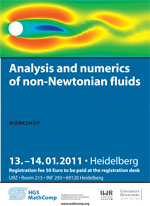
Workshop: „Numerics and Analysis of Non-Newtonian Fluids“
January 13 - 14, 2011
This workshop is taking place in the frame of the HGS MathComp, Interdisciplinary Center for Scientific Computing (IWR), University of Heidelberg. Its main aims are:
- to give a survey of recent developments in the area of non-Newtonian fluid mechanics. The focus is on the following topics: Analysis, numerics, and simulation of non-Newtonian fluids.
- to enable researchers and doctoral students of the Heidelberg Graduate School to gain insights in the area of non-Newtonian fluid mechanics.